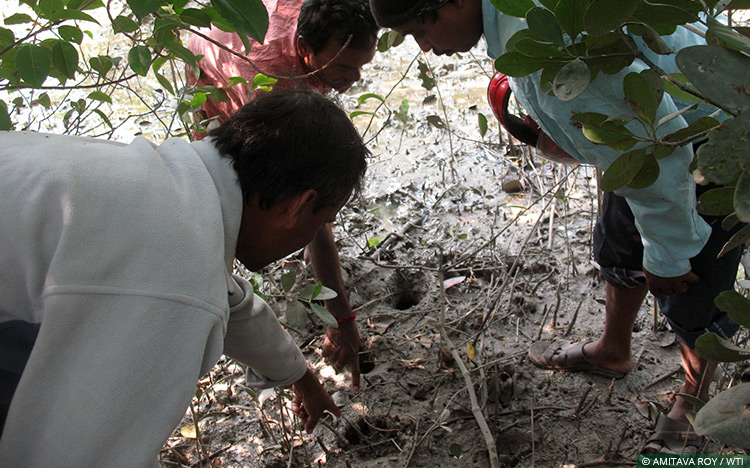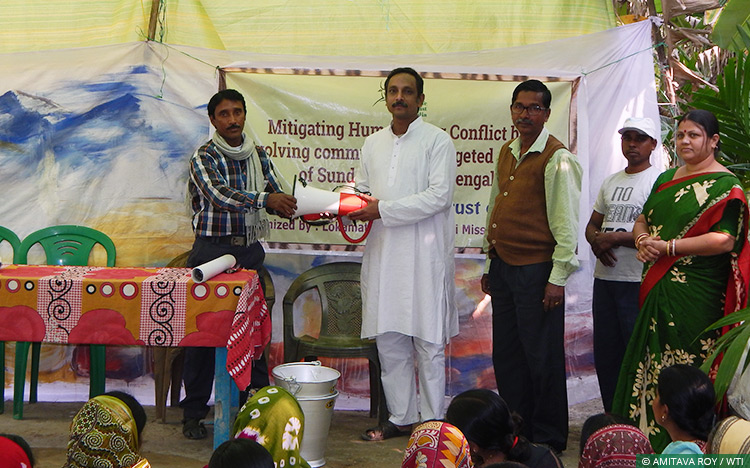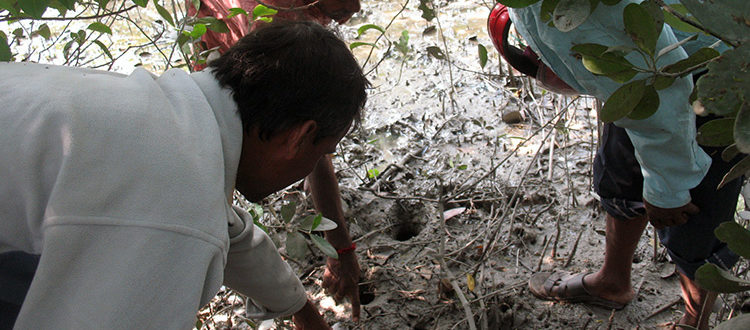Ongoing RAP in the Sundarbans Enlists Help from Local Communities to Mitigate Human-Tiger Conflict
Sundarban National Park, West Bengal, January 18, 2017: In a bid to engage with local communities affected by human-tiger conflict in the Gurguria Bhubaneswari Gram Panchayat in Sundarban National Park, Wildlife Trust of India (WTI), as part of a Rapid Action Project launched last November with support from Mr Kannan Jayaraman under its Wild Aid division, has conducted a number of sensitisation programmes aimed at conflict mitigation in the area.
 Members of a Rapid Response Team assisting forest department personnel track a tiger that had strayed into Kultali village
Members of a Rapid Response Team assisting forest department personnel track a tiger that had strayed into Kultali village
Sundarban National Park is a UNESCO World Heritage that hosts a variety of threatened and endangered species, including the only known wild population of Royal Bengal tigers in a coastal mangrove habitat. Conflict between tigers and humans is a regular occurrence in this landscape; the big cats here are known to prey on livestock and attack people who venture into the forests to fish or collect fuelwood.
In recent years, villages under the Gurguria Bhubaneswari Gram Panchayat have witnessed an increase in tiger encounters within human inhabited areas, especially in the winter months. There has been a considerable rise in livestock depredation as well as human mauling and mortality cases in these conflict prone villages.
Sensitisation programmes have been conducted in high-conflict villages; meetings have been held with local stakeholders, from village heads to fishermen and farmer groups.
WTI has sought to mitigate the immediate threats in the area through its ongoing Rapid Action Project. Sensitisation programmes have been conducted in high-conflict villages such as Purba Gurguria, Madhya Gurguria, Debipur, Bhubaneswari and Deulbari, and just last week, in Maipith. Meetings have been held with local stakeholders, from village heads to fishermen and farmer groups, Block Development Officers and forest department officials.
These interactions have led to the formation of ten Rapid Response Teams (RRTs), comprised of local representatives whose primary responsibility is to assist forest department personnel in driving errant tigers away from human habitations, while managing conflict situations in a manner that keeps the safety of both people and animals paramount. The RRTs were recently equipped with high-powered torches as well as megaphones to sound an alert in case a tiger is sighted in the vicinity of a village; villagers have also suggested that shanks (conch shells used in worship) could be blown to indicate the presence of tigers. The project’s field team has also placed nylon nets as barriers in areas around select villages to prevent the entry of tigers.
 Rapid Response Teams receiving equipment under the project
Rapid Response Teams receiving equipment under the project
These measures have already been seen to have an effect. On December 15, a tiger was reported to have strayed into Kultali village, located near one of the villages covered under the project. The local RRT helped forest staff track the tiger, which was located at the village of Kishorimohonpur five days later. The team also helped in crowd management while the forest department captured and transported the tiger.









